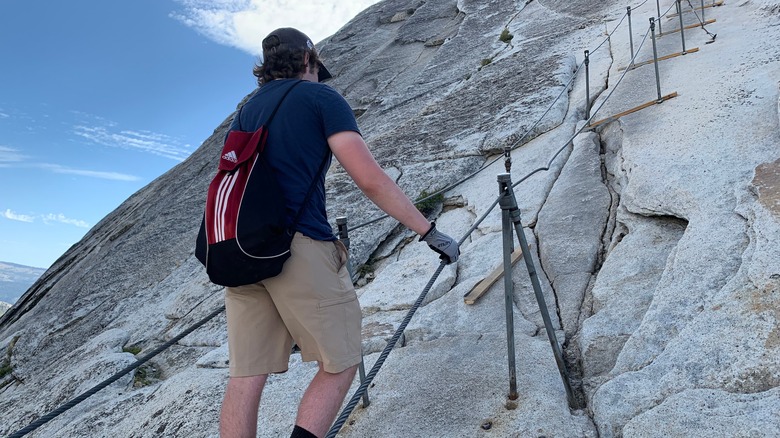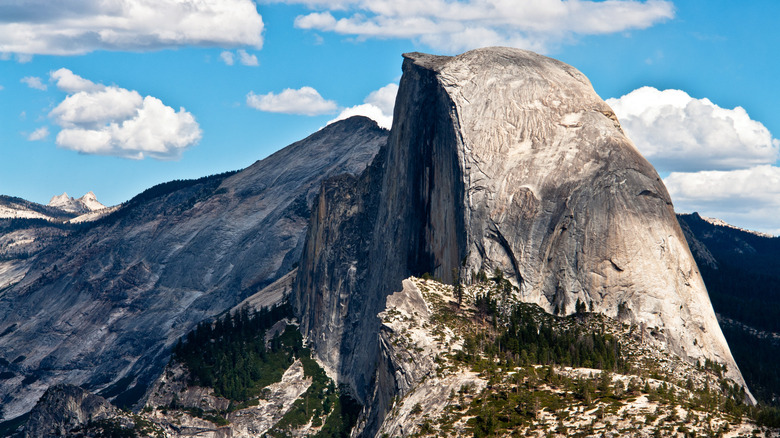One Of The World's Most Iconic Natural Wonders Is A Soul-Satisfying Hike In Yosemite National Park
Yosemite National Park is full of incredible natural sights, but the most impressive may be the iconic Half Dome. This more than 4,700-foot-tall stone has a sheer cliff face as if some enormous knife had sliced off the side of a mountain. There are plenty of good spots in the park for admiring Half Dome, but for some, that's not enough. As impossible as it seems, especially considering how imposing this rock formation is, around 50,000 people can and do climb it every year.
This long, steep hike is not to be underestimated — particularly the heart-stopping final leg of the journey when hikers have to hold on tightly to a pair of cables in order to climb up to the almost vertical rock face at the very top. This route is around 14 miles from start to finish, with more than 5,000 feet of elevation gain, and it takes most hikers a full 12 hours to complete.
It is one of the most dangerous hikes in Yosemite National Park, and while some novice hikers have managed to make it, this is one of those U.S. National Park trails that are better left to experienced hikers. Not only do many have to turn back without reaching the top, but people have tragically died attempting to get to the summit. For those who are able to complete this difficult journey, however, the views and feeling of immense accomplishment can be worth the struggle along the way.
What it's like to hike Yosemite's iconic Half Dome
The journey begins with a walk up a long path of stone steps, which pass the cascading waters of Vernal Fall and then even higher to Nevada Falls. This area is known for its beautiful views, and it's also a popular route for people who aren't planning to go all the way to the top of Half Dome. While it might not look as terrifying as the end of the Half Dome hike, don't underestimate this part of the journey, either. It's easy to slip and injure yourself on the slick, uneven terrain.
From there, you'll trek through Little Yosemite Valley, where many backpackers choose to camp, followed by a walk through the woods. While this beautiful but exhausting route is a fulfilling and challenging experience — for those who dream of reaching the top of Half Dome, it's only half over, and the hard part is yet to come.
Climbing the part of the trail known as "the subdome" means walking up narrow, rugged stairs cut directly into the sheer, almost completely vertical stone at high elevations with no handrails. At this point, there are no trees to shield you, and the sun will likely beat down on you, but that's actually a good thing. If there are any clouds, you might be at risk of a potentially deadly rainstorm and are better off turning back. Finally, you arrive at the cables. This is the most feared part of the hike for good reason, as hikers have to haul themselves up to the very top — and then down again — by holding on to these cables.
How to prepare for the Half Dome hike
A successful Half Dome hike starts long before you arrive at Yosemite National Park. You should ensure you're fit enough for such a strenuous trek and may want to practice some pulling exercises to prepare for the cables. In addition to good hiking boots, you absolutely need a pair of gloves. Without them, your hands will be unprotected on the cables, and you can easily end up with nasty blisters, which, as well as being painful, would make your descent even more dangerous. You should also pack a water filter to refill your water bottles at the Merced River — otherwise, you'll need to carry a large amount of heavy water up the Half Dome.
If you're going to attempt Half Dome, you must have a permit. To keep crowds down and make the hike safer, only 300 permits are given out per day. There are some issues with the Half Dome Hike's lottery system, but it's still the only legal way to attempt the hike. To enter the lotteries (pre-season or daily permit two days in advance), you will have to follow the lottery process put in place by the National Park Service. You'll have to pay a $10 fee just to apply, and then if you win a permit, you'll have to pay another $10 to secure your spot. If you cannot secure a permit but will be in the park either way, try communicating with the rangers and other hikers to see if anyone has an empty slot on their permit that you can use — but there's no guarantee.


